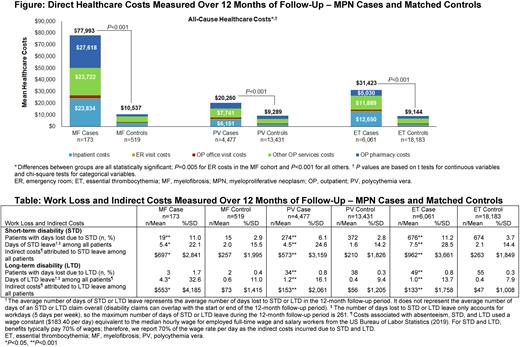Abstract
Background: Myeloproliferative neoplasms (MPNs) are clonal blood diseases characterized by an overproduction of blood cells and include myelofibrosis (MF), polycythemia vera (PV), and essential thrombocythemia (ET). Over the course of illness, these disorders can impose substantial economic burden, in both direct and indirect healthcare costs, due to lost work productivity and medical leave. The objective of this study was to measure work loss (short-term and long-term disability [STD/LTD]) and direct and indirect costs for patients with MPNs among US employees.
Methods: In this retrospective cohort study, MarketScan administrative claims databases were used to identify employed patients (aged 18-64 years) with ≥1 diagnosis of an MPN (cohorts for MF, PV, and ET identified separately) from 1/1/2009 to 12/31/2019. The latest date meeting all eligibility criteria in the selection window was set as the index. Patients were required to have 6 months of continuous database enrollment (with medical, pharmacy, and work loss data available) before (pre-index period) and 12 months after (follow-up period) the index date. Patients with evidence of pregnancy during follow-up, a diagnosis of acute myeloid leukemia (AML; all cohorts), myelodysplastic syndrome (MDS; PV and ET cohort only), or MF (PV and ET cohort only) at any point during the study were excluded. A control cohort of patients without evidence of MPN, AML, or MDS during the entire study period and meeting the same enrollment criteria as the MPN cohorts was also selected (index date randomly assigned). Direct matching on age and sex followed by propensity score matching (1:3 ratio) methods were used to adjust for differences in other patient demographics and comorbidities before measuring outcomes. The proportion of patients with STD or LTD, number of days lost from work, and associated indirect and direct healthcare costs (overall and by service category) were reported for the MF, PV, and ET cohorts and compared with matched controls during the 12-month follow-up period; subsets of each MF, PV, and ET cohort who experienced a thrombotic event (TE) were also analyzed.
Results: The number of patients with MF, PV, and ET included in the analysis were 173, 4,477, and 6,061, respectively. After matching, patients with an MPN were well balanced with controls (defined as standard mean difference of <0.1) on all demographic and clinical characteristics. Median age was 54, 51, and 48 years for MF, PV, and ET patients, respectively. Total direct healthcare costs and those of each of the components (ie, inpatient, outpatient, and pharmacy) were significantly higher among all 3 MPN cohorts compared with controls (Figure). The largest mean cost difference was observed in the MF cohort ($67,456 higher), followed by the ET cohort ($22,279 higher) and the PV cohort ($10,970 higher). The MPN cohorts also had a significantly larger proportion of patients with an STD claim, a larger number of days lost from work due to STD, and higher associated indirect costs related to STD compared with controls. Patients in the MF cohort had an 8.1% higher chance of filing a STD claim, followed by the ET cohort (7.5% higher) and the PV cohort (3.3% higher). Results were consistent but less pronounced for LTD due to the small proportion of patients with LTD during the 12-month follow-up period, which may not be long enough to observe the diseases' impact (Table).
In the subsets of patients with ET and PV with a TE, the mean total direct healthcare costs were substantially larger than those observed for the full ET and PV cohorts (ET: $74,279 higher and PV: $45,219 higher), and the difference in the percentage of patients filing a STD claim was also substantially larger (ET: 20.5% higher and PV: 11.6% higher).
Conclusions: This real-world analysis found high economic burden among employed patients with MPNs. Patients with MF, PV, and ET were significantly more likely to take disability leave and had higher direct and indirect costs compared with matched controls. The presence of TEs more than tripled direct costs and nearly tripled use of disability leave for patients with PV or ET compared with the full PV or ET cohorts.
Disclosures
Yu:Incyte Corporation: Current Employment, Current equity holder in publicly-traded company. Jerry:Incyte Corporation: Consultancy. Nelson:Incyte Corporation: Consultancy. Marlin:Incyte Corporation: Consultancy. Braunstein:Incyte Corporation: Current Employment, Current equity holder in publicly-traded company. Princic:Incyte Corporation: Consultancy.
Author notes
Asterisk with author names denotes non-ASH members.


This feature is available to Subscribers Only
Sign In or Create an Account Close Modal